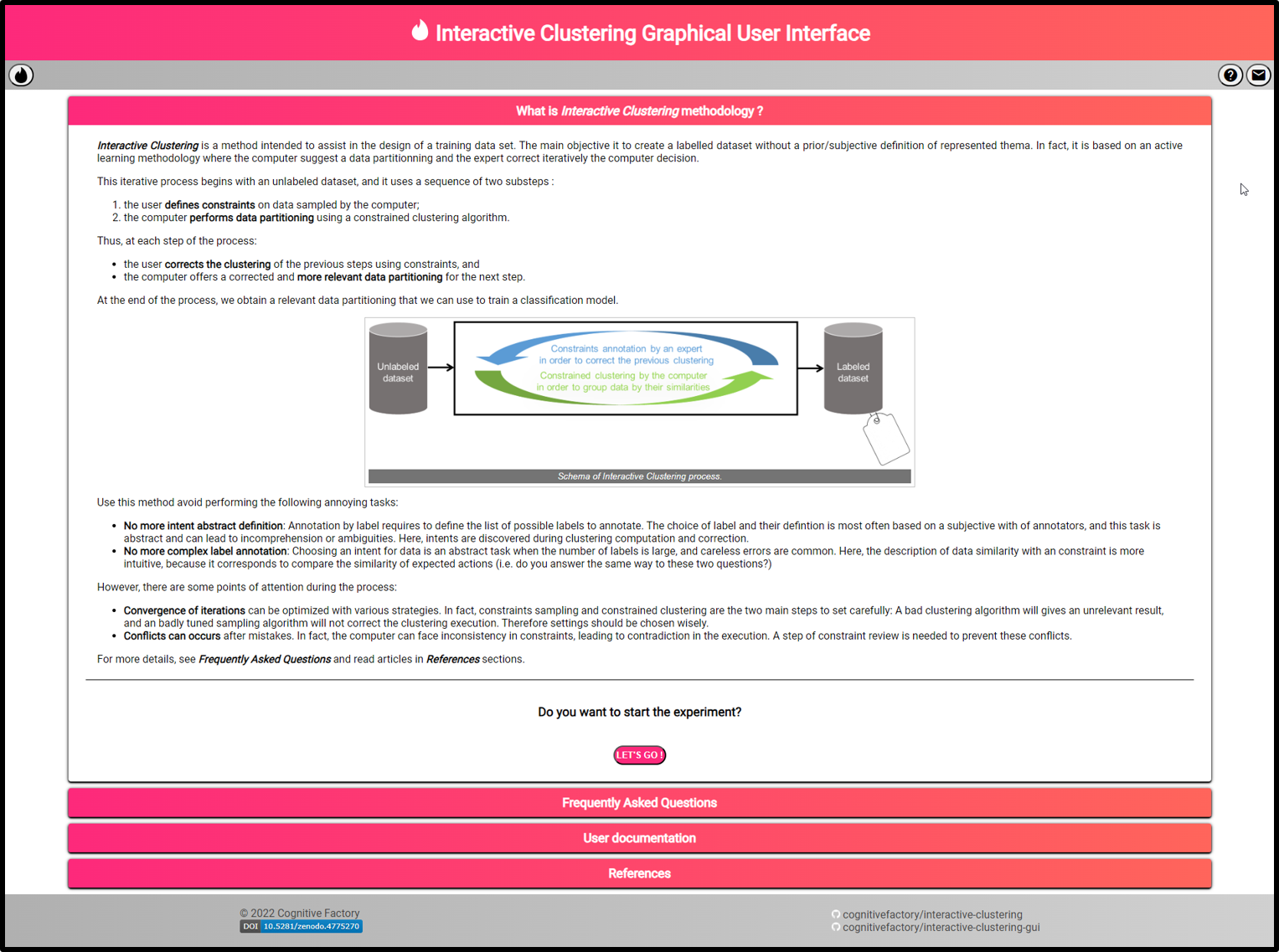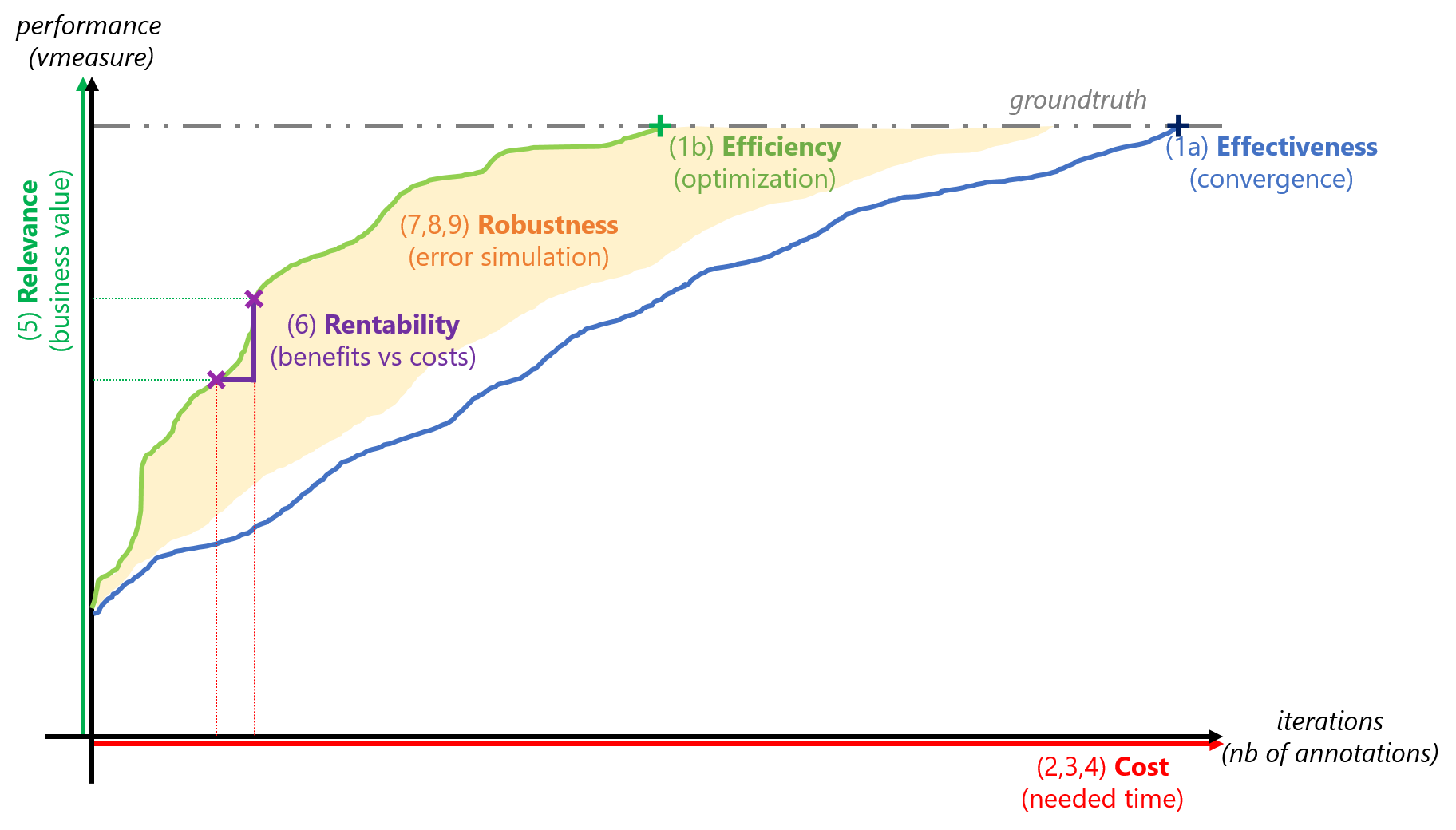Several comparative studies of cognitivefactory-interactive-clustering functionalities on NLP datasets.
Interactive clustering is a method intended to assist in the design of a training data set.
This iterative process begins with an unlabeled dataset, and it uses a sequence of two substeps :
-
the user defines constraints on data sampled by the machine ;
-
the machine performs data partitioning using a constrained clustering algorithm.
Thus, at each step of the process :
-
the user corrects the clustering of the previous steps using constraints, and
-
the machine offers a corrected and more relevant data partitioning for the next step.
Simplified diagram of how Interactive Clustering works.

Example of iterations of Interactive Clustering.

An implementation of this methodology is available on GitHub: cognitivefactory/interactive-clustering. For more details, read its main documentation.
Furthermore, a web application based on Interactive Clustering Methodologoy is available on GitHub: cognitivefactory/interactive-clustering-gui. For more details, read its main documentation.
Welcome page of Interactive Clustering Web Application.

Several studies are provided here:
efficience: Aims to confirm the technical efficience of the method by verifying its convergence to a ground truth and by finding the best implementation to increase convergence speed.computation time: Aims to estimate the time needed for algorithms to reach their objectives.annotation time: Aims to estimate the time needed to annotated constraints.constraints number: Aims to estimate the number of constraints needed to have a relevant annotated dataset.relevance: Aims to confirm the relevance of clustering results.rentability: Aims to predict the rentability of one more iteration.inter annotator: Aims to estimate the inter-annotators score during constraints annotation.annotation errors and conflicts fix: Aims to evaluate errors impact and verify conflicts fix importance on labeling.annotation subjectivity: Aims to estimate the labeling difference impact on clustering results.
Organizational diagram of the different Comparative Studies of Interactive Clustering.

All these studies are used in the following PhD report : Schild, 2024 (in press)
Used datasets are:
- "French trainset for chatbots dealing with usual requests on bank cards" (Schild, 2021): This dataset represents examples of common customer requests relating to bank cards management. It can be used as a training set for a small chatbot intended to process these usual requests.
- Subset of "MLSUM: The Multilingual Summarization Corpus" (Schild et Adler, 2023): A subset of newspapers articles in most popular category. It can be used to train a small newspaper classifier.
Interactive Clustering Comparative Study requires:
Python 3.8 or above.
Check that the Python location is in yourPATH variable.
For Windows, the following directories should be in your PATH:
$HOME/AppData/Local/Programs/Python/Python38;$HOME/AppData/Local/Programs/Python/Python38/Scripts;$HOME/AppData/Roaming/Python/Python38/Scripts.
R 4.Y or above.
Check that the R location is in yourPATH variable.
For Windows, it can be:
C:\Program Files\R\R-4.Y.Z/bin.$HOME/AppData/Local/Programs/R/R-4.Y.Z/bin.
Create a virtual environment with venv:
# Upgrade pip.
python3 -m pip install --upgrade pip
# Create a virtual environment.
mkdir -p $HOME/.envs/
python3 -m venv $HOME/.envs/interactive-clustering-comparative-studyInstall requirements with pip, spacy and R:
# Activate the virtual environment.
source $HOME/.envs/interactive-clustering-comparative-study/Scripts/activate
# Install Jupyter dependencies.
python -m pip install "jupyter" # jupyter notebook.
python -m pip install "ipykernel" # python kernel.
R -e "install.packages('IRkernel', repos='https://cran.r-project.org/')" # r kernel.
R -e "install.packages('pillar', repos='https://cran.r-project.org/')"
R -e "IRkernel::installspec()" # r kernel spec settings.
# Install Python dependencies.
python -m pip install "cognitivefactory-interactive-clustering>=1.0.0" # interactive-clustering package.
python -m pip install "fr-core-news-md @ https://github.com/explosion/spacy-models/releases/download/fr_core_news_md-3.4.0/fr_core_news_md-3.4.0.tar.gz" # spacy language model (the one you want, with version "3.4.x").
python -m pip install "en-core-web-md @ https://github.com/explosion/spacy-models/releases/download/en_core_web_md-3.4.0/en_core_web_md-3.4.0.tar.gz" # spacy language model (the one you want, with version "3.4.x").
python -m pip install "cognitivefactory-features-maximization-metric>=1.0.0" # Features Maximization Metric.
python -m pip install "datasets" # Hugging Face datasets.
python -m pip install "matplotlib" # graph management.
python -m pip install "openai" # llm call.
python -m pip install "openpyxl" # xlsx file management.
python -m pip install "pandas" # data management.
python -m pip install "simpledorff" # krippendorff's alpha.
python -m pip install "tabulate" # pandas display.
python -m pip install "tqdm" # bar progress.
python -m pip install "xlsxwriter" # xlsx file management.
# Install R dependencies.
R -e "install.packages('sjstats', repos='https://cran.r-project.org/')" # common statistics.
R -e "install.packages('lme4', repos='https://cran.r-project.org/')" # linear and mixed models.
R -e "install.packages('emmeans', repos='https://cran.r-project.org/')" # estimated marginal means.
R -e "install.packages('lmerTest', repos='https://cran.r-project.org/')" # Welch-Satterthwaite effective degrees of freedom analysis.
R -e "install.packages('pbkrtest', repos='https://cran.r-project.org/')" # Kenward-Roger approach for t test.
R -e "install.packages('pbnm', repos='https://cran.r-project.org/')" # parametric bootstrap, see https://support.posit.co/hc/en-us/articles/200711843-Working-Directories-and-Workspaces-in-the-RStudio-IDE#:~:text=The%20current%20working%20directory%20is,getwd()%20in%20the%20console.For developments, some packages can be installed for quality and types checking:
# Activate the virtual environment.
source $HOME/.envs/interactive-clustering-comparative-study/Scripts/activate
# Install Python dependencies.
python -m pip install "black>=21.10b0" # code formatting.
python -m pip install "black[jupyter]" # code formatting.
python -m pip install "isort>=5.7.0" # code formatting.
python -m pip install "mypy>=0.910" # type checking.
python -m pip install "darglint>=1.5.8" # quality checking.
python -m pip install "autoflake>=1.4" # quality checking.
python -m pip install "flake8-bandit>=2.1" # quality checking.
python -m pip install "flake8-black>=0.2" # quality checking.
python -m pip install "flake8-bugbear>=21.3" # quality checking.
python -m pip install "flake8-builtins>=1.5" # quality checking.
python -m pip install "flake8-comprehensions>=3.4" # quality checking.
python -m pip install "flake8-docstrings>=1.5" # quality checking.
python -m pip install "flake8-pytest-style>=1.4" # quality checking.
python -m pip install "flake8-string-format>=0.3" # quality checking.
python -m pip install "flake8-tidy-imports>=4.2" # quality checking.
python -m pip install "flake8-variables-names>=0.0" # quality checking.
python -m pip install "pep8-naming>=0.11.1" # quality checking.
python -m pip install "wps-light>=0.15.2" # quality checking.All results are zipped in .tar.gz files and versioned on Zenodo: Schild, E. (2021). cognitivefactory/interactive-clustering-comparative-study. Zenodo. https://doi.org/10.5281/zenodo.5648255.
Warning ! These experiments can use a huge disk space and contain hundreds or even thousands of files (1 per execution attempt). See the table below before extracting the files.
| STUDY NAME | FOLDER SIZE | .tar.gz FILE SIZE |
|---|---|---|
1_efficience_study |
1.4 Go | 0.7 Go |
2_computation_time_study |
1.1 Go | 0.1 Go |
3_annotation_time_study |
0.1 Go | 0.1 Go |
4_constraints_number_study |
12.0 Go | 2.7 Go |
5_relevance_study |
0.1 Go | 0.1 Go |
6_rentability_study |
1.3 Go | 0.1 Go |
7_inter_annotators_score_study |
0.1 Go | 0.1 Go |
8_annotation_error_fix_study |
28.0 Go | 3.5 Go |
9_annotation_subjectivity_study |
82.0 Go | 11.3 Go |
Launch Jupyter Notebook with:
# Activate the virtual environment.
source $HOME/.envs/interactive-clustering-comparative-study/Scripts/activate
# Run jupyter at http://localhost:8888/tree (the port number can change)
jupyter notebookThen follow notebooks instructions.
Use the command tar -czf ../experiments.tar.gz ../experiments/ to wrap results in a .tar.gz file,
and use tar -xzf ../experiments.tar.gz -C ../ to unwrap them.
To check code quality of scripts and notebooks:
./scripts/code-quality-checking.sh-
Interactive Clustering:
- PhD report:
Schild, E. (2024, in press). De l'Importance de Valoriser l'Expertise Humaine dans l'Annotation : Application à la Modélisation de Textes en Intentions à l'aide d'un Clustering Interactif. Université de Lorraine.; - First presentation:
Schild, E., Durantin, G., Lamirel, J.C., & Miconi, F. (2021). Conception itérative et semi-supervisée d'assistants conversationnels par regroupement interactif des questions. In EGC 2021 - 21èmes Journées Francophones Extraction et Gestion des Connaissances. Edition RNTI. https://hal.science/hal-03133007.; - Theoretical study:
Schild, E., Durantin, G., Lamirel, J., & Miconi, F. (2022). Iterative and Semi-Supervised Design of Chatbots Using Interactive Clustering. International Journal of Data Warehousing and Mining (IJDWM), 18(2), 1-19. http://doi.org/10.4018/IJDWM.298007. https://hal.science/hal-03648041.; - Methodological discussion:
Schild, E., Durantin, G., & Lamirel, J.C. (2021). Concevoir un assistant conversationnel de manière itérative et semi-supervisée avec le clustering interactif. In Atelier - Fouille de Textes - Text Mine 2021 - En conjonction avec EGC 2021. https://hal.science/hal-03133060.; - Interactive Clustering implementation:
Schild, E. (2021). cognitivefactory/interactive-clustering. Zenodo. https://doi.org/10.5281/zenodo.4775251; - Interactive Clustering web application:
Schild, E. (2022). cognitivefactory/interactive-clustering-gui. Zenodo. https://doi.org/10.5281/zenodo.4775270; - Features Maximization Metric implementation:
Schild, E. (2023). Cognitivefactory/Features-Maximization-Metric. Zenodo. https://doi.org/10.5281/zenodo.7646382
- PhD report:
-
Datasets:
- Bank cards management:
Schild, E. (2021). French trainset for chatbots dealing with usual requests on bank cards [Data set]. Zenodo. http://doi.org/10.5281/zenodo.4769949; - MLSUM:
Schild, E. & Adler, M. (2023). Subset of 'MLSUM: The Multilingual Summarization Corpus' for constraints annotation experiment (1.0.0 [subset: fr+train+filtered]) [Data set]. Zenodo. https://doi.org/10.5281/zenodo.8399301.
- Bank cards management:
-
Experimental protocol:
- Jupyter Notebooks:
Kluyver, T., Ragan-Kelley, B., Pérez, F., Granger, B., Bussonnier, M., Frederic, J., Kelley, K., Hamrick, J., Grout, J., Corlay, S., Ivanov, P., Avila, D., Abdalla, S., Willing, C. & Jupyter development team, (2016) Jupyter Notebooks - a publishing format for reproducible computational workflows. In Positioning and Power in Academic Publishing: Players, Agents and Agendas. IOS Press. pp. 87-90 . https://doi.org/10.3233/978-1-61499-649-1-87; - Sklearn:
Buitinck, L., Louppe, G., Blondel, M., Pedregosa, F., Mueller, A., Grisel, O., Niculae, V., Prettenhofer, P., Gramfort, A., Grobler, J., Layton, R., Vanderplas, J., Joly, A., Holt, B., & Varoquaux, G. (2013). API design for machine learning software: experiments from the scikit-learn project. ArXiv, abs/1309.0238; - statsmodel
Seabold, S., & Perktold, J. (2010). Statsmodels : Econometric and Statistical Modeling with Python, 92-96. https://doi.org/10.25080/Majora-92bf1922-011; - simpledorff:
Perry, T. (2021). LightTag : Text Annotation Platform. Proceedings of the 2021 Conference on Empirical Methods in Natural Language Processing : System Demonstrations, 20-27. https://aclanthology.org/2021.emnlp-demo.3; - matplotlib:
Caswell, T. A., Droettboom, M., Lee, A., Sales de Andrade, E., Hunter, J., Hoffmann, T., & Ivanov, P. (2021). matplotlib/matplotlib: REL: v3.3.4 (Version v3.3.4). Zenodo. https://doi.org/10.5281/zenodo.4475376; - Python:
Van Rossum, G., & Drake, F. L. (2009). Python 3 Reference Manual (CreateSpace). - R:
Team, R. C. (2017). R : A language and environment for statistical computing. R Foundation for Statistical Computing. Vienna, Austria. https://www.R-project.org/
- Jupyter Notebooks:
Schild, E. (2021). cognitivefactory/interactive-clustering-comparative-study. Zenodo. https://doi.org/10.5281/zenodo.5648255